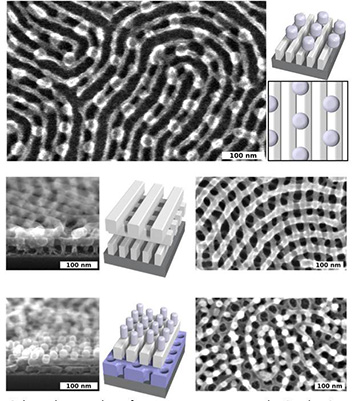Tricking Self-Assembly into Creating New Shapes
January 16, 2017
What is the scientific achievement?
In self-assembly, molecules are designed to form in a spontaneous manner desired structures, allowing rapid and scalable fabrication. However, this paradigm generates a limited set of simple shapes. CFN staff scientists have demonstrated how layers of self-assembling materials can be used to create nanostructures never realized before. Each layer guides the assembly of subsequent layers, allowing novel structures to be designed.
Why does this achievement matter?
By vastly increasing the diversity and sophistication of nanomaterials, increasingly demanding multi-functional applications can be pursued and realized.
What are the details?
 enlarge
enlarge
Selected examples of new nanostructures obtained using layered assembly. Top row: Nano-dots are guided to align between every second layer of a line pattern. Middle & bottom rows: Complex, nanoporous architectures can be precisely fabricated with this method.
CFN Capabilities:
CFN’s Materials Synthesis & Characterization Facility was used for the synthesis and electron microscopy characterization of the polymer assemblies.
Publication Reference
Atikur Rahman, Pawel W. Majewski, Gregory Doerk, Charles T. Black & Kevin G. Yager, Non-native three-dimensional block copolymer morphologies, Nature Communications 7, 13988 (2016)
DOI: 10.1038/ncomms13988
https://www.bnl.gov/newsroom/news.php?a=111895
http://www.nature.com/articles/ncomms13988
Acknowledgement of Support
Research carried out at the Center for Functional Nanomaterials, and the National Synchrotron Light Source II, Brookhaven National Laboratory, which are supported by the U.S. Department of Energy, Office of Basic Energy Sciences, under Contract No. DE-SC0012704.
2017-12211 | INT/EXT | Newsroom









